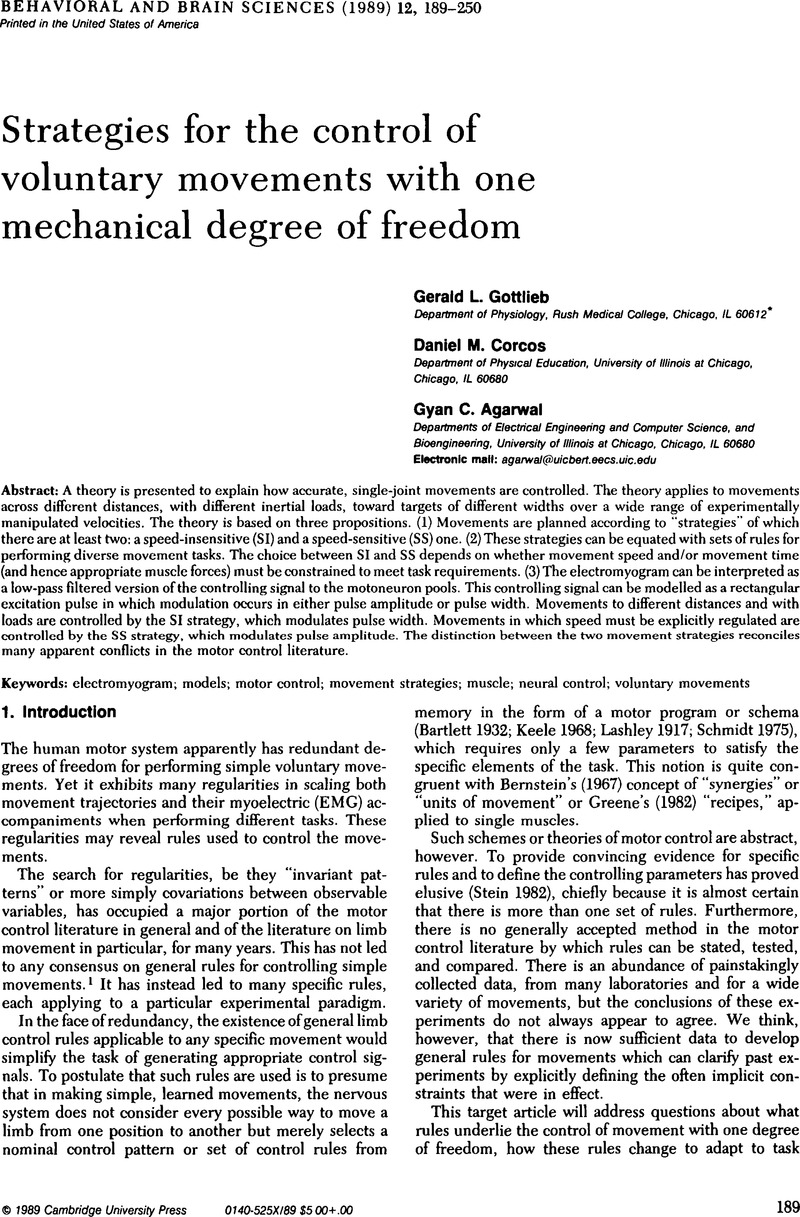Crossref Citations
This article has been cited by the following publications. This list is generated based on data provided by Crossref.
Jamison, J.Christopher
and
Caldwell, Graham E.
1994.
Dual degree of freedom tasks: Flexion effect on supination/pronation response.
Journal of Electromyography and Kinesiology,
Vol. 4,
Issue. 3,
p.
143.
Gielen, C. C. A. M.
and
van Bolhuis, B.
1995.
Reciprocal and coactivation commands are not sufficient to describe muscle activation patterns.
Behavioral and Brain Sciences,
Vol. 18,
Issue. 4,
p.
754.
Windhorst, U.
1995.
Levers to generate movement.
Behavioral and Brain Sciences,
Vol. 18,
Issue. 4,
p.
784.
Giszter, Simon
1995.
The case of the missing CVs: Multi-joint primitives.
Behavioral and Brain Sciences,
Vol. 18,
Issue. 4,
p.
755.
lngvaldsen, R.
and
Whiting, H.T.A.
1995.
Frameworks on shifting sands.
Behavioral and Brain Sciences,
Vol. 18,
Issue. 4,
p.
764.
Loeb, Gerald E.
1995.
What can we expect from models of motor control?.
Behavioral and Brain Sciences,
Vol. 18,
Issue. 4,
p.
767.
Hodgson, Antony
1995.
The unobservability of central commands: Why testing hypotheses is so difficult.
Behavioral and Brain Sciences,
Vol. 18,
Issue. 4,
p.
763.
van Emmerik, R. E. A.
and
Wagenaar, R. C.
1995.
Equifinality and phase-resetting: The role of control parameter manipulations.
Behavioral and Brain Sciences,
Vol. 18,
Issue. 4,
p.
783.
Kay, Bruce A.
1995.
Frames of reference interact and are task-dependent.
Behavioral and Brain Sciences,
Vol. 18,
Issue. 4,
p.
765.
Fikes, Thomas G.
and
Townsend, James T.
1995.
Moving models of motion forward: Explication and a new concept.
Behavioral and Brain Sciences,
Vol. 18,
Issue. 4,
p.
751.
Feldman, Anatol G.
and
Levin, Mindy F.
1995.
The origin and use of positional frames of reference in motor control.
Behavioral and Brain Sciences,
Vol. 18,
Issue. 4,
p.
723.
Smeets, Jeroen B. J.
1995.
Two joints are more than twice one joint.
Behavioral and Brain Sciences,
Vol. 18,
Issue. 4,
p.
779.
Desmurget, Michel
Rossetti, Yves
and
Prablanc, Claude
1995.
Natural unconstrained movements obey rules different from constrained elementary movements.
Behavioral and Brain Sciences,
Vol. 18,
Issue. 4,
p.
750.
Alexander, R. McN.
1995.
Tendon elasticity and positional control.
Behavioral and Brain Sciences,
Vol. 18,
Issue. 4,
p.
745.
Goodman, Simon R.
1995.
Inverse kinematic problem: Solutions by pseudoinversion, inversion and no-inversion.
Behavioral and Brain Sciences,
Vol. 18,
Issue. 4,
p.
756.
Morasso, Pietro
and
Sanguineti, Vittorio
1995.
Kinematic invariances and body schema.
Behavioral and Brain Sciences,
Vol. 18,
Issue. 4,
p.
769.
Partridge, Lloyd D.
1995.
Let us accept a “controlled trade-off” model of motor control.
Behavioral and Brain Sciences,
Vol. 18,
Issue. 4,
p.
773.
Scott, Stephen H.
1995.
Can the λ model be used to interpret the activity of single neurons?.
Behavioral and Brain Sciences,
Vol. 18,
Issue. 4,
p.
778.
Winters, Jack M.
1995.
How far should we extend the equilibrium point (lambda) hypothesis?.
Behavioral and Brain Sciences,
Vol. 18,
Issue. 4,
p.
785.
Wright, Charles E.
and
States, Rebecca A.
1995.
Biological variability and control of movements via δλ.
Behavioral and Brain Sciences,
Vol. 18,
Issue. 4,
p.
786.



